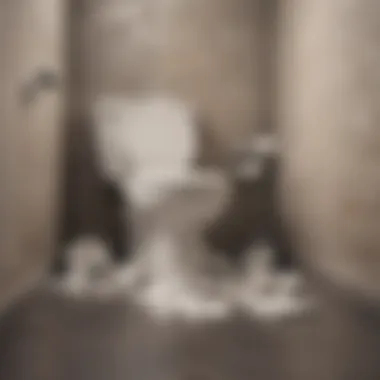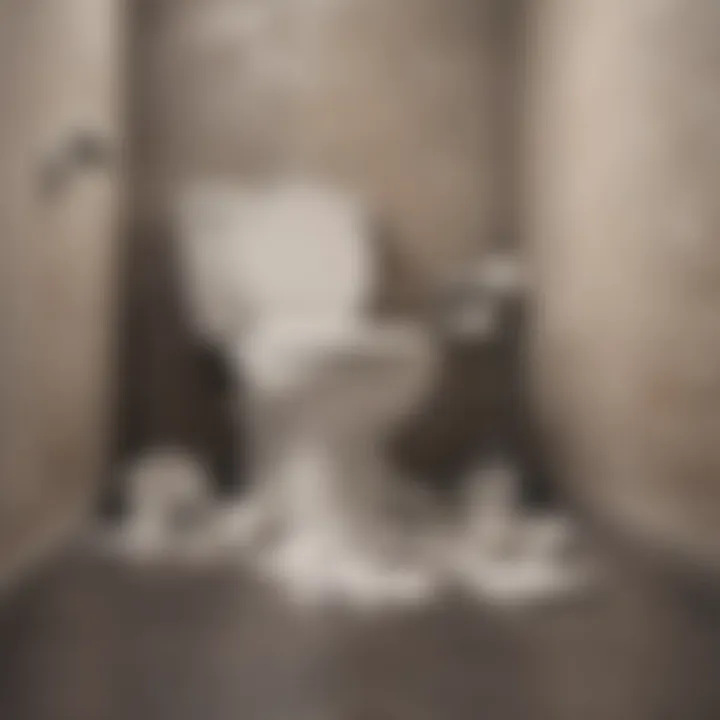Managing Toilet Blockages from Excessive Paper Use


Intro
Toilet blockages are an issue often overlooked until they present a significant inconvenience. Among the various causes of such problems, excessive paper usage stands out as a primary contributor. Understanding the intricacies of toilet plumbing and the role of paper can help mitigate these frustrating occurrences. This narrative will guide homeowners, real estate enthusiasts, and interior decorators in realizing how to approach and manage this common issue.
Knowing how paper interacts with plumbing systems lays the foundation for better prevention and resolution strategies.
Understanding Toilet Mechanics
The operation of a toilet is relatively straightforward, yet it is influenced by various factors. When a toilet is flushed, water is released from the tank into the bowl. This force of water helps to carry waste away through the plumbing system. However, if there is too much paper, it can disrupt this process significantly.
Toilets are designed to handle a specific amount of waste and paper. When that threshold is exceeded, clogs can occur. Numerous factors can contribute to this issue, such as:
- Type of toilet (gravity feed vs. pressure assist)
- Condition of plumbing pipes
- The thickness and absorbency of the paper used
By recognizing these various elements, homeowners can make informed decisions about their paper products, ensuring compatibility with existing plumbing.
Preventive Measures to Reduce Blockages
To avoid blockages, there are several strategies to consider:
- Use thinner paper. Thinner toilet paper breaks down more easily in water and reduces the chances of clogs.
- Limit paper usage. Awareness of how much paper is used during each visit can significantly impact plumbing health. Promoting a habit of fewer sheets can lead to better outcomes.
- Regular maintenance. Routine plumbing checks can help to identify potential issues before they escalate into more significant problems. This can involve simple inspections or engaging professional services.
Adopting these practices contributes to long-term plumbing health, reflecting a proactive approach towards home maintenance.
Effective Removal Strategies
In the event of a blockage, certain techniques can facilitate a successful resolution. Using a toilet plunger is often the first step. Here are some tips for effective use:
- Ensure the plunger forms a complete seal over the hole in the bowl.
- Use firm, vertical movements to create suction and pressure.
- If the blockage persists, it may be necessary to employ an auger to reach further into the plumbing.
In extreme cases where DIY methods fail, contacting a plumbing professional is advisable. Expertise can effectively handle deeper blockages that typical tools cannot reach.
Implications of Blockages on Plumbing Systems
Regular blockages can lead to more severe plumbing issues over time. Persistent clogs may cause:
- Backflow and damage to pipes
- Increased repair costs
- Public health concerns if waste is not disposed of properly
By addressing blockages promptly and understanding their root causes, homeowners can safeguard their plumbing systems and ensure efficiency and hygiene in their bathrooms.
Suggestions for Minimizing Paper Use
Papers are essential for hygiene but can be suggested to minimize. Some practical techniques include:
- Educating family and guests on responsible usage.
- Placing toilet paper holders conveniently to discourage excessive grabbing.
- Considering alternatives such as bidets, which can significantly reduce the need for paper.
Prologue to Toilet Blockages
Toilet blockages are an all-too-common issue faced by homeowners. Understanding this problem is important not just for convenience, but also for maintaining the integrity of plumbing systems. The topic includes key elements such as the mechanics behind toilets, common causes, and preventive measures. By detailing the components that contribute to blockages, one can make informed choices about maintenance and usage.
The discussion centers around various factors like excessive paper usage, which often leads to complications in residential plumbing. This subject is not only pertinent but also beneficial for anyone aiming to enhance the functionality of their bathrooms while avoiding costly repairs.
Understanding Toilet Mechanisms
Composition of toilets
The composition of toilets typically includes materials like porcelain, which is strong but also smooth. This characteristic allows waste to flow with ease, which is beneficial for preventing blockages. Porcelain is easy to clean and durable. However, it can be prone to cracking if not handled properly.
Another common material is plastic, often found in lighter and more affordable toilet designs. While this offers a decreased likelihood of breakage, it can wear down more quickly over time. Therefore, choosing the right material is critical for effective toilet function.
How toilets flush
The flushing mechanism of a toilet uses gravity and water flow to remove waste. When a toilet is flushed, a valve opens, allowing water to rush from the tank into the bowl. This is a key characteristic because it relies on the right amount of water pressure and volume to clear waste effectively.
A unique aspect to note is the siphon action that happens during a flush. This feature helps create a vacuum that pulls waste down into the drain. If too much toilet paper is used, it can disrupt this action, leading to blockages. Understanding how the flush works is important for avoiding problems.
Role of trap and drain
The role of the trap and drain is crucial in the toilet's plumbing system. The trap holds a small amount of water, which serves as a barrier to prevent foul odors from entering the home. This characteristic also aids in waste removal when the toilet is flushed.


One downside is that if the trap is overflowed or blocked by excessive paper usage, this can lead to backups. Moreover, the drain's incline must be maintained correctly to ensure proper waste flow. The design of trap and drain is advantageous as it supports efficient waste management when functioning correctly.
Causes of Blockages
Overview of common blockages
Common blockages in toilets arise from various sources. Solid waste, excessive toilet paper, and foreign objects often play significant roles. Recognizing these contributors is key to addressing sewer issues effectively. This is particularly beneficial for homeowners to understand, as it highlights the importance of monitoring what goes into the toilet.
Unique to blockages is the interaction of these elements; for instance, solid waste combined with excessive paper can quickly cause a clog. By being aware of this, one can prevent blockages from occurring.
Impact of excessive paper usage
Excessive paper usage stands out as a leading cause of toilet blockages. When more paper is used than the toilet can handle, problems arise. A toilet is generally designed to manage a certain volume of waste, and beyond that, complications can occur.
This issue is important as it directly affects hygiene and functioning in the bathroom. Another unique feature is the degree to which different types of paper dissolve. Less dissolve friendly options can exacerbate this problem. Therefore, being mindful of paper choice and quantity is crucial.
Other contributing factors
In addition to paper, other factors can contribute to blockages. Items such as wipes, feminine hygiene products, or even small toys can disrupt the flushing mechanism. Their commonality makes awareness essential for effective bathroom maintenance.
Another aspect worth noting is the age of the plumbing system. Older pipes may have existing issues that make them more susceptible to blockages, especially when combined with excessive paper use. Understanding these factors allows for a more comprehensive preventative approach.
Identifying the Problem
Identifying a blockage in the toilet is an essential part of managing excessive paper usage issues. Recognizing signs early can prevent further complications. Homeowners must be aware of the symptoms that indicate a blockage. Understanding these signs leads to prompt actions. This can save time and money in the long run. Detecting the severity of the blockage assists in deciding whether to take immediate action or call a plumber.
Signs of a Blocked Toilet
Slow drainage
Slow drainage is one of the first indicators that something is amiss. In an optimal situation, water should disappear swiftly after a flush. If there is noticeable delay, it often means that toilet is struggling to handle its waste. This sign can escalate into a more severe blockage if ignored. Recognizing this early helps in addressing the problem before it worsens.
Advantages of noticing slow drainage include the ability to take timely action. However, relying too heavily on this sign can be a disadvantage, as it may be mistaken for other plumbing issues.
Unusual noises
Unusual noises, such as gurgling or bubbling can indicate an obstruction. When the toilet is flushed, the water flow should produce only minimal sounds. If there are strange sounds, it often reflects air trying to escape from a blockage. This can suggest air trapped in the pipes, which may also affect the drainage system. Paying attention to these noises can prevent potential backups and unpleasant odors from developing.
The strength of including unusual noises as a sign is their swift identification of possible issues. However, such noises can also be sporadic and might not always relate to a blockage, confusing the homeowner.
Overflow incidents
Overflow incidents are a clear and alarming signal of a blockage. If the toilet bowl fills to the brim or the water spills onto the floor, it may be due to an excessive paper buildup, coupled with other waste. Such an occurrence can lead to significant water damage and unpleasant cleanup requirements. When faced with an overflow, immediate action is necessary to prevent damage to the bathroom and the home.
The unique feature of overflow incidents highlights a major plumbing crisis, making it undeniably significant. Yet, this extreme sign may often indicate that the situation has escalated beyond simple troubleshooting. It is important to handle these incidents carefully to avoid further complications.
Assessing the Severity
Assessing the severity of a blockage helps to gauge its impact and decide on appropriate action. This involves looking at how much the function of the toilet has been affected. Gauging severity means reviewing whether the toilet is just slow or if it has completely stopped functioning.
Degree of blockage
The degree of blockage reflects how much waste and excessive paper are affecting flow. A minor blockage might only cause slow drainage, whereas a major one could completely impede flow. Identifying this correctly influences the urgency of the response. A minor blockage might allow a homeowner to take simple actions like plunging, while a major blockage often requires a professional plumber.
Understanding the degree of blockage leads to improved decision-making on the actions required. The drawback is that this assessment can be subjective and often overlooked until a significant issue arises.
Immediate consequences
Immediate consequences are crucial to understanding the urgency of a blockage. If the toilet appears to be malfunctioning, it can lead to further plumbing issues beyond just that fixture. This can create a cascading effect throughout the plumbing system, increasing potential repair costs. Examining immediate effects helps prioritize the urgency of dealing with a blockage.
Recognizing immediate consequences can alert owners to other issues, such as the potential for water damage. However, they may also cause anxiety regarding cost and repairs and can sometimes lead to panic responses without proper evaluation.
Potential plumbing damage
Potential plumbing damage underscores a serious aspect of toilet blockages. Chronic blockages can cause wear and tear on pipes, leading to leaks or complete failures. When excessive paper leads to repeated blockages, long-term implications on the plumbing's structural integrity need consideration. Homeowners should evaluate how older systems might be more adversely affected.
The focus on potential plumbing damage positions the discussion towards the bigger picture of home maintenance. However, it may cause unnecessary anxiety about repair costs and the condition of the plumbing if not properly contextualized.
Preventive Measures to Avoid Blockages
Preventive measures play a crucial role in managing toilet blockages. By understanding and applying these measures, homeowners can significantly reduce the incidence of blockages caused by excessive paper usage. This section focuses on the importance of optimal paper usage and regular maintenance practices, both integral to keeping plumbing systems functioning efficiently.


Optimal Paper Usage
Types of toilet paper
Choosing the right type of toilet paper is essential. Not all toilet papers are created equal. Some are designed to dissolve quickly in water, minimizing the risk of clogs. Others, particularly thicker or scented variations, may not break down as easily. Selecting a toilet paper that is labeled as "septic-safe" or "biodegradable" is advisable, as these types tend to disintegrate more readily. The unique feature here is that easily dissolvable paper minimizes the chances of blockages. However, users should be aware that thinner papers might take adjusting to in terms of comfort and effectiveness.
Understanding dissolution rates
Dissolution rates of toilet paper are an important aspect affecting plumbing systems. It refers to the speed at which paper breaks down in water. Understanding this can help users make better choices on what to use. Opting for products with a faster dissolution rate decreases the likelihood of paper accumulation in pipes. A product that disintegrates within seconds is preferable for maintaining a clear drain line. However, certain brands may not provide the desired comfort, which can complicate choices for users looking to balance comfort and functionality.
Recommended amounts
Using the correct amount of toilet paper is crucial in preventing blockages. Many individuals tend to use an excessive amount without realizing the impact. Typically, experts recommend using no more than three to four sheets per wipe. This not only helps maintain sanitation but also keeps the plumbing system clearer. Teaching about proper paper amounts can reduce the frequency of blockages. However, some may find this limiting and feel that it compromises their hygiene routine.
Regular Maintenance Practices
Routine inspections
Conducting routine inspections of your toilet can catch problems early. Regular checks ensure that everything functions properly. It is advisable to look for any slow drainage signs or unusual noises. Routine inspections are beneficial because they allow homeowners to identify and address potential blockages before they develop. This preventive measure can sometimes prevent the need for costly interventions. However, not all homeowners may be inclined to perform these checks regularly due to time constraints or lack of awareness.
Plumber checks
Engaging a professional plumber for routine checks highlights an effective preventive measure. Professional plumbers can assess the overall condition of plumbing systems. They identify any underlying issues that might lead to blockages. Regular plumbing maintenance not only addresses existing problems but can enhance the lifespan of the plumbing system. It often involves utilizing specialized equipment and expertise. However, the cost of professional services may deter some homeowners from scheduling these checks.
Incorporating flushable products
With the wide range of products available today, using specifically labeled flushable products can help enhance hygiene while minimizing blockage risks. These products are designed to break down easily in water, similar to toilet paper. Incorporating flushable wipes or other products can assist in maintaining cleanliness, provided they are truly designed for toilet use. On the cautionary side, some products marketed as flushable can cause blockages and are not recommended. Users should always check the packaging and choose brands known for reliable dissolution properties.
Effective toilet management is about understanding usage and maintenance. Small changes can make a significant difference in plumbing health.
In summary, by adhering to optimal paper usage and engaging in systematic maintenance practices, homeowners can confidently mitigate the risks of toilet blockages. Being proactive in these areas will ultimately contribute to a more functional bathroom environment.
Addressing a Blocked Toilet
Addressing a blocked toilet is crucial in understanding how to effectively manage the consequences of excessive paper usage. Blockages can lead to significant plumbing issues and disrupt daily life while causing unpleasant odors and mess. It is essential to know how to respond quickly and efficiently when a blockage occurs. This section covers a systematic approach to addressing the very problem at hand, presenting the methods available and the benefits each offers to achieve a quick resolution.
Initial Response Steps
Assessing water levels
Assessing water levels is an important first step when dealing with a blocked toilet. If the water level is too high, it poses a risk of overflow during intervention. This characteristic makes it critical for anyone facing a blockage. By evaluating the water level accurately, you can determine the next steps appropriately. A unique feature of this approach is that it allows for informed decisions, reducing the likelihood of causing further mess. However, neglecting this key assessment may lead to a more challenging situation caused by overflow.
Deciding on intervention
Deciding on intervention involves understanding what actions to take next based on the severity of the blockage. This choice greatly influences the effectiveness and safety of the entire process. The key characteristic here is that identifying the right intervention can save time and prevent damage. For example, deciding immediately to plunge might help but could also worsen the blockage if done incorrectly. A unique benefit of assessing your options is that it prepares you for the most appropriate action, leading to a potentially quicker resolution of the blockage.
Safety precautions
Safety precautions are vital during the process of addressing a blockage. This element ensures the well-being of the person attempting to solve the issue. Key aspects of safety precautions include wearing gloves and considering the use of a mask to avoid exposure to unpleasant odors. This includes being cautious with chemical cleaners that can harm the skin or cause respiratory issues. A significant advantage to prioritizing safety is the ability to focus on the task at hand without risking personal health.
Using a Plunger
Choosing the right plunger
Choosing the right plunger is an essential aspect for effective blockage removal. Not all plungers are designed the same way; some are more effective for certain types of blockages than others. The key characteristic of the right plunger is its suction cup design, which allows for better pressure application. The distinct features of various plungers can determine success rates; for example, a flange plunger generally works better for toilets as it forms a better seal. Having the appropriate tool on hand greatly aids in the blockage resolution process.
Effective plunging techniques
Effective plunging techniques also play a crucial role in solving toilet blockages. Maintaining a sturdy grip and using a firm, up-and-down motion can help to create the necessary pressure to dislodge the blockage. The key characteristic here is that proper technique can lead to faster results. It’s important to note that doing it wrong may lead to a more difficult blockage. Keeping the plunger submerged is another recommended practice. This technique will ensure consistent pressure is applied to resolve the issue without losing suction.
Post-plunge checks
Post-plunge checks follow immediately after the plunging process. It is a simple yet crucial step to ensure that the blockage has been resolved. The key characteristic of post plunging checks is monitoring the toilet's drainage. Observing whether the water drains as normal can help confirm that further action is not necessary. However, neglecting this step could lead to unexpected issues later, such as minor blockages developing again and causing inconvenience.
Permanent Solutions
Using a toilet auger
Using a toilet auger provides a means of addressing stubborn blockages that a plunger cannot clear. This flexible and specialized tool reaches deeper into the plumbing system, helping to break clogs that are difficult to reach. The key characteristic here is its ability to navigate bends in the pipes. Effective use of the toilet auger can lead to a more permanent solution compared to plunging alone. However, it requires some skill and care, as improper use can damage toilet bowls.
Chemical drain cleaners


Chemical drain cleaners offer another method to clear toilet blockages. These products often contain harsh chemicals that can dissolve organic matter and paper quickly. Their key characteristic is that they can work relatively fast if done properly. Nevertheless, they also present disadvantages, such as potential harm to plumbing if overused and risk to human health if mishandled. It is important to follow the guidelines provided by the manufacturers to avoid complications.
Calling a professional plumber
Calling a professional plumber should not be overlooked as a viable solution. Professional plumbers bring expertise and specialized tools that can handle even the most persistent blockages. The key characteristic here is their ability to assess the situation thoroughly. Their unique feature is the experience they possess in identifying the underlying causes of recurring blockages. While this option may come at a cost, it often saves time and prevents further plumbing issues from developing.
Implications for Plumbing Systems
The topic of plumbing systems is vital in understanding how excessive paper usage impacts the overall efficiency and functionality of home toilets. When one considers plumbing, it is essential to recognize that systems must be designed to handle specific waste loads. The introduction of excessive amounts of toilet paper can disrupt this balance. This section dives into the various implications caused by frequent blockages in plumbing systems.
Consequences of Frequent Blockages
Effects on piping
The effects on piping due to frequent blockages can be quite severe. Blocked pipes often lead to backups, creating stress in plumbing systems. One key characteristic is that persistent blockages can result in cracks or leaks in pipes. Structural damage to these pipelines can lead to costly repairs and extensive home damage. Repeated blockages are not just annoyances; they can lead to significant issues in plumbing integrity. The unique feature causing these problems often stems from users flushing too much paper, leading to a cascading effect of blockages.
Long-term maintenance costs
Long-term maintenance costs associated with plumbing systems facing frequent blockages can escalate quickly. Regularly resolving these issues requires both time and money, making it a significant financial burden for homeowners. A key characteristic of these costs is their cumulative nature. Each incident adds to repair bills and may require hiring professionals, which can be quite expensive. Additionally, the costs can deter people from keeping up with proper maintenance, leading to a vicious cycle of escalating expenses.
Impact on overall plumbing health
The overall health of the plumbing system is another critical aspect affected by habitual blockages. Frequent disruptions can lead aging systems toward failure. One vital feature to consider is that every blockage creates strain on pipes and fittings, increasing the risk of urgent plumbing issues. This aspect is important as it indicates a declining health of the plumbing system. Maintaining an understanding of the implications of blockages is essential for homeowners aiming to preserve their plumbing system's integrity.
Adapting Home Plumbing
Adapting home plumbing systems can provide a proactive approach to managing the effects of excessive paper usage. Simple adjustments and upgrades can greatly improve how plumbing responds to waste, including toilet paper.
Choosing appropriate fixtures
Choosing appropriate fixtures is one way to reduce the risk of blockages. Modern toilet designs, such as low-flow toilets, can handle waste more efficiently. A critical aspect of selecting these fixtures is their ability to operate effectively with a limited amount of water, an essential characteristic in reducing blocks. By minimizing excess waste, appropriate fixtures can significantly limit the potential for issues caused by paper-based blockages. The disadvantage, however, is that some older homes may require retrofitting to accommodate modern designs.
Upgrading aging systems
Upgrading aging systems is also a practical consideration. Over time, plumbing systems can wear out, making them susceptible to blockages and leaks. A key element in this process is recognizing when components need replacement. An upgrade can enhance the overall performance of the plumbing system significantly. While this choice is beneficial, the cost associated with such upgrades can be a deterrent for many homeowners.
Utilizing water-efficient designs
Utilizing water-efficient designs in plumbing can serve as a preventative measure against blockages caused by excessive paper usage. These designs often feature advanced flushing mechanisms that reduce water consumption while maintaining efficiency. A vital characteristic of these systems is their ability to handle solid and paper waste concurrently. This adaptability can greatly enhance the plumbing system's overall performance. However, an initial investment may be necessary, which could be a consideration for some homeowners.
In summary, the implications of excessive paper usage on plumbing systems are significant. Addressing these issues through preventive measures and system adaptations can help maintain both functionality and efficiency.
Understanding these points is crucial in managing and preventing the challenges posed by blockages, particularly for those who are keen on maintaining their homes.
Culminations and Recommendations
Summary of Key Insights
Recap of causes and solutions
Blockages in toilets primarily arise from three main causes: excessive paper usage, foreign objects, and general wear and tear of plumbing systems. The solutions presented include proper paper use, regular maintenance, and the professional assistance of plumbing experts. Each of these solutions provides a systematic approach to mitigating blockages, thus improving the overall functionality of toilet systems. Proper awareness of the causes can lead to more efficient handling of issues when they arise. This approach has the advantage of helping homeowners make informed decisions and take proactive measures.
Importance of preventive measures
Preventive measures are essential for avoiding future blockages in toilets. These measures include educating household members about appropriate toilet paper usage and scheduling routine inspections. The importance lies in the fact that prevention is significantly less expensive than repair. Waste minimized prevents larger issues from developing, hence reducing costs associated with emergency plumbing services. Implementing preventive strategies promotes a healthier plumbing system and can prolong the lifespan of fixtures.
Consequences of neglect
Neglecting regular maintenance and proper toilet usage can have detrimental consequences. These include increased plumbing repair costs and more frequent emergency calls to professionals. An overlooked blockage can lead to severe plumbing damage, which often necessitates extensive repairs. Acknowledging the repercussions of negligence encourages homeowners to adopt better habits concerning toilet use and maintenance.
Future Considerations
Emerging plumbing technologies
The development of emerging plumbing technologies holds significant promise in addressing blockages. Innovations such as smart toilets and improved trap designs offer advanced solutions to enhance daily sanitation. These technologies can actively prevent blockages, ultimately saving money in repairs while improving user convenience and hygiene. As plumbing technology evolves, homeowners should consider integrating these advancements into their systems.
Changing toilet paper standards
Toilet paper standards are continually evolving, with manufacturers focusing on producing more biodegradable and dissolvable options. This change directly impacts the blockage issues discussed in this article. Choosing toilet paper that disintegrates more easily can lead to fewer blockages and, in turn, reduces the strain on plumbing systems. Homeowners should prioritize these options for better plumbing health and sustainability.
Environmental concerns
The link between excessive paper usage and environmental issues cannot be ignored. As awareness of ecological footprints increases, the push to reduce paper waste becomes clearer. Understanding this relationship helps individuals to be better informed about their choices. Selecting more environmentally friendly toilet options reduces impact on landfills and resources.
"Choosing the right paper products leads not only to better plumbing but also to better environmental outcomes."
In summary, effective management of toilet blockages hinges on informed decisions, proactive practices, and adapting to changing standards and technologies. With proper knowledge and continuous efforts, homeowners can maintain cleanliness, functionality, and sustainability in their bathroom spaces.















